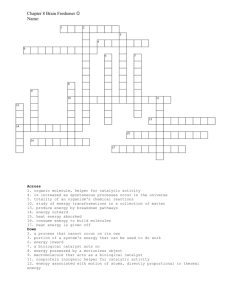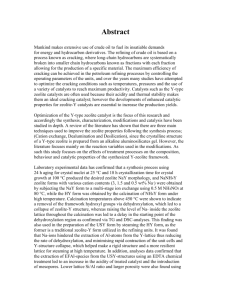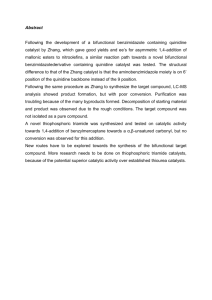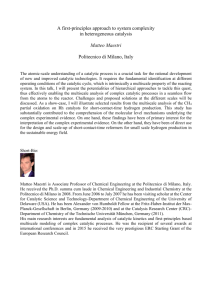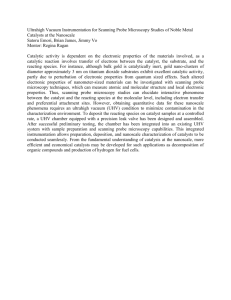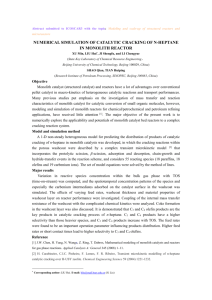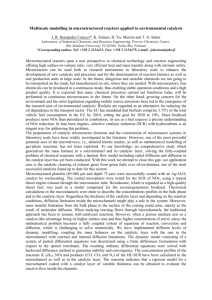Investigation of catalytic craking of waste polyethylene
advertisement
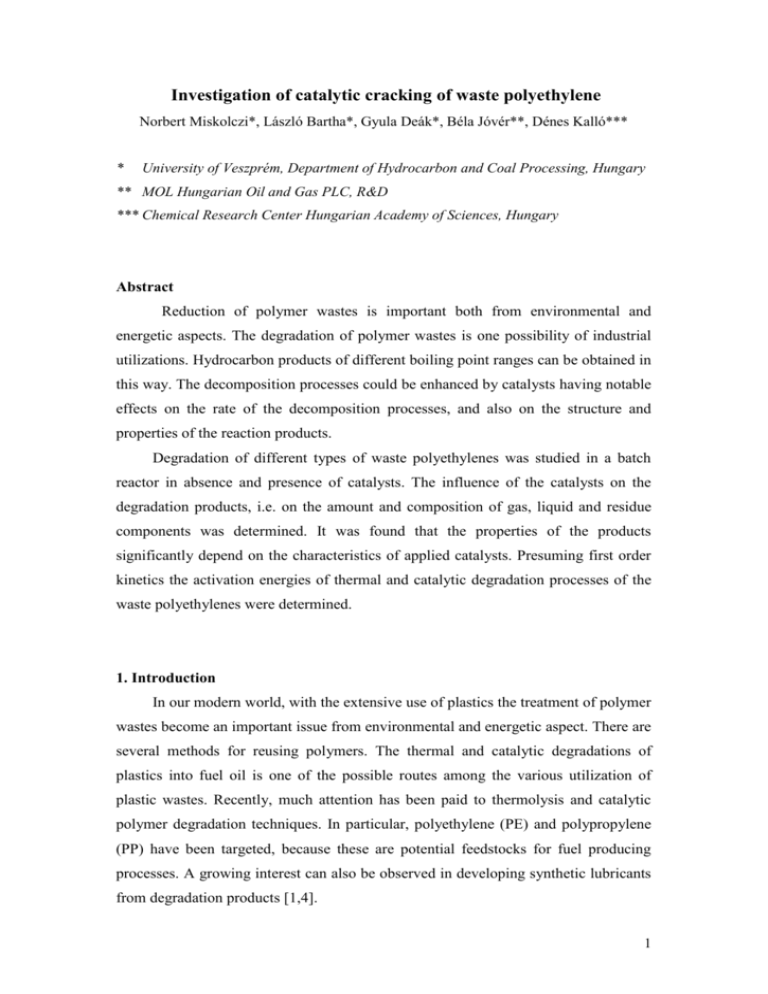
Investigation of catalytic cracking of waste polyethylene Norbert Miskolczi*, László Bartha*, Gyula Deák*, Béla Jóvér**, Dénes Kalló*** * University of Veszprém, Department of Hydrocarbon and Coal Processing, Hungary ** MOL Hungarian Oil and Gas PLC, R&D *** Chemical Research Center Hungarian Academy of Sciences, Hungary Abstract Reduction of polymer wastes is important both from environmental and energetic aspects. The degradation of polymer wastes is one possibility of industrial utilizations. Hydrocarbon products of different boiling point ranges can be obtained in this way. The decomposition processes could be enhanced by catalysts having notable effects on the rate of the decomposition processes, and also on the structure and properties of the reaction products. Degradation of different types of waste polyethylenes was studied in a batch reactor in absence and presence of catalysts. The influence of the catalysts on the degradation products, i.e. on the amount and composition of gas, liquid and residue components was determined. It was found that the properties of the products significantly depend on the characteristics of applied catalysts. Presuming first order kinetics the activation energies of thermal and catalytic degradation processes of the waste polyethylenes were determined. 1. Introduction In our modern world, with the extensive use of plastics the treatment of polymer wastes become an important issue from environmental and energetic aspect. There are several methods for reusing polymers. The thermal and catalytic degradations of plastics into fuel oil is one of the possible routes among the various utilization of plastic wastes. Recently, much attention has been paid to thermolysis and catalytic polymer degradation techniques. In particular, polyethylene (PE) and polypropylene (PP) have been targeted, because these are potential feedstocks for fuel producing processes. A growing interest can also be observed in developing synthetic lubricants from degradation products [1,4]. 1 Most of the previous studies were performed on thermal degradation (pyrolysis) of wastes. These processes require high temperature even up to 1000°C [2]. By catalytic degradation of wastes the required energy might be decreased, because the degradation temperature of wastes could be decreased with catalysts. The zeolites and clay minerals are the most commonly used catalysts. They have effects also on the structure of products, so when the target product is the diesel fuel isomerization catalysts might be not advantageous [3]. The effects of the additive content in waste PE on the degradation have not been reported in the literature yet. This paper will focus on the degradation as a function of the type of the catalysts and additive content of the waste polymer. 2. Experiments 2.1. Materials Different additive containing waste low density polyethylene (LDPE) grains were studied. One of them had filler content (FCPE) the other one not (FFPE). The main physical properties of the wastes are summarized in Table 1. Table. 1. Properties of polyethylene wastes Polymer FCPE FFPE Polymer type LDPE LDPE TiO2, CaCO3 - 5 6 0,925 0,929 140-150 120-130 Filler material Average grain size, mm Density, g/cm3 Softening range, °C One natural clay mineral (NCM) and an equilibrium FCC zeolite catalyst (FCC-I) were used. The FCC-I catalyst has significant macro- and microporous surface area (BET surface area: 184 m2/g, microporous surface area: 114 m2/g), while the NCM catalyst has only significant macroporous surface area. Nitrogen was used as inert atmosphere. 2.2. Apparatus The cracking apparatus is shown in Fig. 1. 250 cm3 glass batch reactor was fitted with a dip tube to introduce nitrogen and a thermocouple to measure the 2 temperature of the molten polymer in the reactor. Nitrogen bubbling resulted in mixing the melted polymer and catalyst. Volatile polymer cracking products were conducted through a condenser to separate liquid and gas products. The liquid was sampled at set intervals, and the samples were analyzed. T Nitrogen Waste PE Gases +Q E-3 E-4 Liquid product E-2 Residue Fig. 1. Apparatus for waste polyethylene cracking 2.3. Liquid product analysis Liquid products formed in cracking reactions were analyzed with the following methods. iodine-bromine number determination (ASTM-D 149-60) density measurement (MSZ EN ISO 12185) determination of Engler distillation curve (ASTM-D 1078) The olefin double bond distribution was determined with SHIMIDAZU IR-470 type spectrometer. 2.3. Reaction parameters The following parameters were used: Temperature: 420, 450°C Residence time: 0-330 min. Waste polyethylenes: FFPE FCPE Catalysts: FCC-I NCM Catalyst concentration: 1 (w/w%) 3 3. Results 3.1. Yields The thermal and catalytic degradation behavior of waste LDPE was investigated. Figs. 2 and 3 show the liquid yields as functions of cracking time at 420 and 450 °C. 90 80 Liquid product, % 70 60 50 40 Thermal (FCPE) Catalytic (FCC-I), (FCPE) Catalytic (NCM), (FCPE) Thermal, (FFPE) Catalytic (FCC-I), (FFPE) Catalytic (NCM), (FFPE) 30 20 10 0 0 50 100 150 200 Degradation time, min. 250 300 350 Fig. 2. Effect of reaction time on yields at 420°C 100 90 80 Liquid product, % 70 60 50 40 Thermal (FCPE) Catalytic (FCC-I), (FCPE) Catalytic (NCM), (FCPE) Thermal, (FFPE) Catalytic (FCC-I), (FFPE) Catalytic (NCM), (FFPE) 30 20 10 0 0 10 20 30 40 Degradation time, min. 50 60 70 Fig. 3. Effect of reaction time on yields at 450°C 4 Liquid yields increased with the cracking time for both types of waste PE as shown in Figs. 2 and 3. While the degradation was practically complete within one hour at 450°C, it took more than five hours to reach a liquid yield of 80% at 420 oC. In the presence of catalysts higher yields were observed at both temperatures. The catalysts significantly affected the product yields taking into account that thermal reactions proceed in the entire volume (in three dimensions) while the catalytic transformations on the contact surfaces (in two dimensions), only. At 450°C a higher coke formation was observed. Lighter liquid colors were observed in the presence of catalysts becoming dark yellow by the end of the reaction. At higher temperatures the yields were higher and the gap between thermal and catalytic degradations is significantly smaller than at 420°C (due to the greater activation energy of the former, vide infra). The activity of the FCC-I catalyst was higher than the activity of the NCM at 450°C. The activity of the catalysts decreased with time. Some degradation reactions were considered of first order in the literature 5. Thus we used the following rate equation: dm km dt where m: weight of the waste polymer; k: reaction rate constant. The calculated activation energies are given in Table 2. Using catalysts resulted in a decrease of the phenomenological activation energy. Table 2. – Activation energies of cracking Activation energy, kJ/mol Thermal Catalytic (FCC-I) Catalytic (NCM) FFPE 368 357 359 FCPE 369 359 360 3.2. Structure of products Two methods were used for the determination of the olefin content of the liquid fractions: one based on the iodine-bromine number, and the other one on the IR spectra. Fig. 4 shows the iodine-bromine numbers of liquid fractions as functions of the cracking time at 420°C. The olefin content of the liquid product decreased with time. The changes during the catalytic cracking were more significant than during the 5 thermal cracking. In the case of 190 IBr number, g I/100g product thermal Thermal (FCPE) Catalytic (FCC-I), (FCPE) Catalytic (NCM), (FCPE) Thermal, (FFPE) Catalytic (FCC-I), (FFPE) Catalytic (NCM), (FFPE) 170 150 bromine the numbers iodine- of liquid fractions decreased slightly with 130 the reaction time. The iodinebromine 110 numbers of liquid fractions as functions of cracking 90 time 70 0 50 100 150 200 250 300 350 Degradation time, min. Fig. 4. – The IBr number of liquids vs. cracking time at 420°C at 450°C are shown in Fig. 5. Smaller found differences among were iodine-bromine numbers at 450°C than at 420°C. 115 110 IBr number, g I/100g product cracking Thermal (FCPE) Catalytic (FCC-I), (FCPE) Catalytic (NCM), (FCPE) Thermal, (FFPE) Catalytic (FCC-I), (FFPE) Catalytic (NCM), (FFPE) 105 100 95 The olefin content was also lower at 450°C. Figs. 4 and 5 show that the catalytic activities decreased with the reaction time, and 90 85 greater activity was observed at 80 lower 75 temperatures. At both temperatures the natural clay 70 0 5 10 15 20 25 30 Degradation time, min. 35 40 45 mineral catalyst is of lower Fig. 5. – The IBr number of liquids vs. cracking time at 450°C activity. The decrease of the catalyst activity could be attributed to the formation of Vinyl Internal 1,1-disubstitued carbonaceous deposits blocking 80 Olefin content, (V/V%) 70 the active centers of the catalyst. 60 50 Different filler and pigment 40 containing waste polyethylenes 30 20 were used in the experiments. 10 The additive content of polymer 0 30 120 300 30 FCPE 120 300 FFPE Degradation time, min. Fig. 6. – The distribution of olefin double bonds of liquids vs. cracking time at 420°C without catalyst did not significantly influence the characteristics of end products. Double bond isomerization was observed in catalytic processes. 6 Vinyl Internal Figs. 6, 7 and 8 show the 1,1-disubstitued 90 distribution of olefin double Olefin content, (V/V%) 80 bonds at different cracking times. 70 60 The olefin content of liquid 50 fractions decreased with time (in 40 30 accordance 20 10 with the iodine- bromine numbers in Figs. 4 and 0 30 120 300 30 120 FCPE 300 5). The double bond content of FFPE the products of thermal cracking Degradation time, min. Fig. 7. – The distribution of olefin double bonds of liquids vs. cracking time at 420°C with catalyst (FCC-I) is lower than that of catalytic cracking. The liquid products had significant vinyl and -olefin Vinyl Internal 1,1-disubstitued content, 90 Olefin content, (V/V%) 80 approximately 50(V/V%). The distributions of 70 olefin double bond at different 60 50 times of catalytic cracking are 40 30 given in Figs. 7 and 8. 20 Differences 10 0 30 120 300 30 120 FCPE 300 FFPE can be observed between thermal and catalytic cracking. Catalysts stimulated the Degradation time, min. Fig. 8. – The distribution of olefin double bonds of liquids vs. cracking time at 420°C with catalyst (NCM) olefin double bond isomerization. Using catalyst the significant vinyl content observed in thermal 450 cracking Temperature, °C 400 decreased from 350 40(V/V%) to 20 (V/V%), while 300 the internal double bond content 250 increased approximately from 20 200 (V/V%) to 40(V/V%). Using Thermal (FCPE) Catalytic (FCC-I), (FCPE) Catalytic (NCM), (FCPE) Thermal (FFPE) Catalytic (FCC-I), (FFPE) Catalytic (NCM), (FFPE) 150 100 50 catalysts resulted in liquid fractions of higher olefin content. 0 0 10 20 30 40 50 60 70 80 90 100 At higher temperatures the olefin Distillation volume, (V/V%) Fig. 9. – The Engler distillation curve of liquid products contents were lower as well as the vinyl olefin content. 7 Fig. 9 shows the Engler distillation curves of the liquids produced at 420°C. The catalysts influenced the average molecular weight of the liquid products. Using different additive containing polyethylene wastes the Engler curves did not differ from each other. The molecular weight reducing effect of the catalysts can be seen in this Figure, but the type of the catalyst had no significant effect on the average molecular weight of the liquids. 4. Conclusions The cracking of different additive containing waste polyethylenes was investigated in presence of different catalysts and in absence of catalyst at two temperatures. The temperature and catalysts had significant effect on yields of the liquid products. Using catalysts the yields are higher, and significant change in the product composition can be observed (olefin double bond isomerization, higher olefin content). The temperature of the cracking affected the yields and to a less degree the product composition. The catalyst activity decreased with degradation time, and the activation energy of cracking could be decreased by using catalyst. References 1 Ray, I.; Roy, S.; Chaki, T. K.; Khastgir, D.: Studies on thermal degradation behaviour of EVA/LDPE blend, Journal of elastomers and platics 26, 168, (1994) 2 McCaffrey, W. C.; Kamal, M. R.; Cooper, D. G.: Thermolysis of polyethylene, Polymer Degradation and Stability 47, 133, (1995) [3] Manos, G.; Garforth, A.; Dwyer, J.: Catalytic degradation of high-density polyethylene over different zeolitic structures, Ind. Eng. Chem. Res. 39, 1198, (2000) 4 Bate, D. M.; Lehrle, R. S.: Kinetic measurements by pirolysis-gas chromatodraphy, and examples of their use in deducong mechanisms, Polymer Degradation and Stability 39, 1198, (1996) 5 Horvat, N.; Ng, Flora. T. T.: Tertiary polymer recycling: study of polyethylene thermolysis as a first step to synthetic diesel fuel, Fuel 78, 459, (1999) 8
